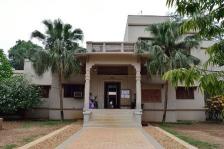One of our members, Ms Sukla Gupta, describes to Mousumi Gupta how the values her upbringing in Tagore’s abode, Santiniketan, imbibed in her helped her cope with the challenges in life.
Ms Sukla Gupta was brought up in Santiniketan, in fact, in Sriniketan in the 1930s and 1940s.
“My father was first posted there with the agricultural development authority in 1932. But for some reason, he left the place and went on to work in some other city. He came back to Santiniketan in 1936 on a call from Rabindranath Tagore, who wanted him to develop the area,” said Ms Gupta. It was from then that the family started to live in Sriniketan, the twin city of Santiniketan.
“The area at that time was almost barren with very less rainfall and agriculture. The place started to develop during his time,” recalls the lady. She was taught in a co-education school in Sriniketan, and the interesting part of that school was all the teachers were women, her mother was also associated with that school.
“The school was till Class VI after which she was shifted to Santiniketan, where she came in contact with several well-known personalities as either teacher or schoolmate. One such big name, Amartya Sen, was two classes senior to me. The way they studied was typical Santiniketan style, classes under the trees, going barefoot, sitting on mats and moreover, no punishment in class and evaluation through grading. The unique part is the students used to shift from one place to another for their classes and not the teachers,” said Ms Gupta.
According to Tagore, children can’t sit at one place for long. There used to be classes, each of 40 minutes’ duration, and 5 minutes to shift with their mat from one place to other. The classes used to get over at 11am. For people belonging to the deprived sections of society, Tagore founded Shiksha Satra (free education). All the poor children from surrounding villages not only studied there free of cost but also got training in craft, tant-knitting, printing, painting, pottery, agriculture etc. in the evening from 5 every day.
"The thought behind was every child had to know and get training in their family’s main occupation, e.g. a farmer’s son had to know about farming, a tanti’s (weaver) son had to know about tant and so on, so that after completing the education they would go back to their respective villages and improve the village with their best educational training," said the lady.
She has also spoken about two important festivals of Halakarshan Utsav and Briksha Ropon Utsav. Briksha Ropon Utsav obviously was planting of saplings. This festival was initiated by Tagore regularly in 1936 and since then it is being continued as ritual of Santiniketan. It not only the festival but also has greeting meaning to save nature. This ceremony is preceded by Halakarshan Utsav.
"Halakarshan Utsav implies ploughing of fields during the end part of August. The ploughing ceremony is a symbolic tribute to the activity of ploughing the land. The ceremony aimed to provide the work of ploughing with the dignity, that was its due," explains Ms Gupta.
The important dignitaries were invited to drive the plough of which her father was one. They used to decorate a flat-topped block with different dals and made a colourful alpana and dressed up two big bullocks with garlands and bright clothes and a hal attached with the bullocks. As a child they were disheartened to see that beautifully decorated block being crushed with the hal.
“The upbringing in that peaceful area gave me the moral values and conduct I carry till now,” she said.
Pic credit: https://commons.wikimedia.org/wiki/File:Kala_Bhavan,_Santiniketan.jpg
Want to share your experience? Please mail your story to writetous@supportelders.com with your name


